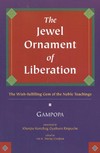 |
Clear Meaning is a thorough introduction to the base, the force, the three bodies, the five wisdoms, and the nine vehicles. It is a Tantra of the Great Perfection, also known as Atiyoga or Dzogchen. This Tantra was first put into writing in India by Prahe Vajra, also known as Garab Dorje, who transmitted it to Ma�jusrimitra, who transmitted it to Sri Singha, who transmitted it to Padmasambhava. Padmasambhava brought Clear Meaning to Tibet and hid it there in the Eighth Century of our era. Over four hundred years later, Guru Chowang (1212-1270) discovered the book, and released it. Because it was treasured away by Padmasambhava and later revealed, it is known as a Treasure (gTer ma). This Tantra is preserved in the Hundred Thousand Tantras of the Ancients (Nyingma Gyubum), and is here translated for the first time into English.
Clear Meaning: The Force of Wisdom Tantra, Christopher Wilkinson, Paperback, 673 pp, $50.00
Christopher Wilkinson began his career in Buddhist literature in 1972 at the age of fifteen, taking refuge vows from his guru Dezhung Rinpoche. In that same year he began formal study of Tibetan language at the University of Washington under Geshe Ngawang Nornang and Turrell Wylie. He then received many instructions from Kalu Rinpoche, completing the traditional practice of five hundred thousand Mahamudra preliminaries. He became a Buddhist monk at the age of eighteen, living in the home of Dezhung Rinpoche while he continued his studies at the University of Washington. He graduated in 1980 with a B.A. degree in Asian Languages and Literature and another B.A. degree in Comparative Religion (College Honors, Magna Cum Laude, Phi Beta Kappa). After a two year tour of Buddhist pilgrimage sites throughout Asia he worked for five years in refugee resettlement in Seattle, Washington, then proceeded to the University of Calgary for an M.A. in Buddhist Studies where he wrote a groundbreaking thesis on the Yangti transmission of the Great Perfection tradition titled "Clear Meaning: Studies on a Thirteenth Century rDzog chen Tantra." He proceeded to work on a critical edition of the Sanskrit text of the 20,000 line Perfection of Wisdom in Berkeley, California, followed by an intensive study of Burmese language in Hawaii. In 1990 he began three years' service as a visiting professor in English Literature in Sulawesi, Indonesia, exploring the remnants of the ancient Sri Vijaya Empire there. He worked as a research fellow for the Shelly and Donald Rubin Foundation for several years, playing a part in the early development of the famous Rubin Museum of Art. In the years that followed he became a Research Fellow at the Centre de Recherches sur les Civilisations de l'Asie Orientale, Collge de France, and taught at the University of Calgary as an Adjunct Professor for five years. He is currently completing his doctoral dissertation, a study of the Yoginitantra first translated into Tibetan during the Eighth century of our era, at the University of Leiden's Institute for Area Studies.
|
|
 |



